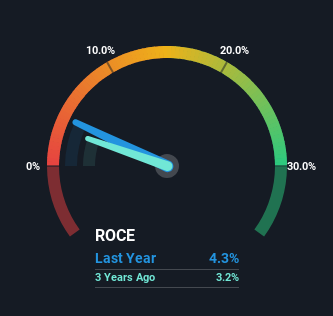Here's What To Make Of Portland General Electric's (NYSE:POR) Decelerating Rates Of Return
Did you know there are some financial metrics that can provide clues of a potential multi-bagger? Typically, we'll want to notice a trend of growing return on capital employed (ROCE) and alongside that, an expanding base of capital employed. If you see this, it typically means it's a company with a great business model and plenty of profitable reinvestment opportunities. Although, when we looked at Portland General Electric (NYSE:POR), it didn't seem to tick all of these boxes.
What Is Return On Capital Employed (ROCE)?
For those that aren't sure what ROCE is, it measures the amount of pre-tax profits a company can generate from the capital employed in its business. The formula for this calculation on Portland General Electric is:
Return on Capital Employed = Earnings Before Interest and Tax (EBIT) ÷ (Total Assets - Current Liabilities)
0.043 = US$456m ÷ (US$12b - US$885m) (Based on the trailing twelve months to March 2024).
So, Portland General Electric has an ROCE of 4.3%. In absolute terms, that's a low return but it's around the Electric Utilities industry average of 4.8%.
See our latest analysis for Portland General Electric
Above you can see how the current ROCE for Portland General Electric compares to its prior returns on capital, but there's only so much you can tell from the past. If you're interested, you can view the analysts predictions in our free analyst report for Portland General Electric .
How Are Returns Trending?
The returns on capital haven't changed much for Portland General Electric in recent years. The company has employed 48% more capital in the last five years, and the returns on that capital have remained stable at 4.3%. This poor ROCE doesn't inspire confidence right now, and with the increase in capital employed, it's evident that the business isn't deploying the funds into high return investments.
The Key Takeaway
In summary, Portland General Electric has simply been reinvesting capital and generating the same low rate of return as before. Unsurprisingly then, the total return to shareholders over the last five years has been flat. All in all, the inherent trends aren't typical of multi-baggers, so if that's what you're after, we think you might have more luck elsewhere.
One final note, you should learn about the 4 warning signs we've spotted with Portland General Electric (including 1 which shouldn't be ignored) .
While Portland General Electric may not currently earn the highest returns, we've compiled a list of companies that currently earn more than 25% return on equity. Check out this free list here.
Have feedback on this article? Concerned about the content? Get in touch with us directly. Alternatively, email editorial-team (at) simplywallst.com.
This article by Simply Wall St is general in nature. We provide commentary based on historical data and analyst forecasts only using an unbiased methodology and our articles are not intended to be financial advice. It does not constitute a recommendation to buy or sell any stock, and does not take account of your objectives, or your financial situation. We aim to bring you long-term focused analysis driven by fundamental data. Note that our analysis may not factor in the latest price-sensitive company announcements or qualitative material. Simply Wall St has no position in any stocks mentioned.
Have feedback on this article? Concerned about the content? Get in touch with us directly. Alternatively, email editorial-team@simplywallst.com

 Yahoo Finance
Yahoo Finance 
